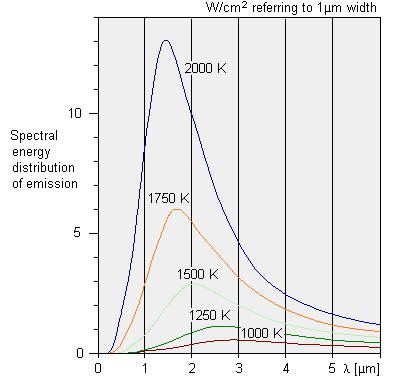| VIAS Encyclopedia provides a collection of tables and definitions commonly needed in science and engineering. |

|

Home  Physics Physics  Planck's Radiation Law Planck's Radiation Law |
|||||
| See also: Wien's Displacement Law, Black Body | |||||






|
|||||
Planck's Radiation Law
About 1900, Max Planck stated a law for the connection between the radiation density of a black cavity (black body) and the temperature of this cavity. Max Planck originally produced this law in an attempt to interpolate between the Rayleigh-Jeans law (which worked at long wavelengths) and Wien's law (which worked at short wavelengths). The meaning of Planck's law lies not only in the fact that this law completely and correctly showed this relation for the first time, but also that the limits of classical physics were being exceeded - inevitably, the quantum nature of the harmonic oscillator must be considered. The permitted energy values of the harmonic oscillator are defined with En = nhν, where n is a whole number, h is the Planck's constant and ν is the natural frequency of the oscillator. Planck postulated this relation, whereas Schrödinger was later able to show that these energy values correspond to the eigenvalues of the harmonic oscillator. This postulate represented the beginning of quantum mechanics. A result of Planck's efforts was Planck's radiation formula which describes the functional dependence on temperature and wavelength for the spectral radiation density:
For hν << kT, Planck's equation with the Rayleigh-Jeans radiation law results in:
For hν >> kT the Wien radiation law results in:
The total energy integrated over all frequencies in a cavity filled with black radiation corresponds to the area under the Planck curve. It is proportional by the fourth power to the temperature .
In Planck's law, the dual character of light emerges for the
first time. M. Strauss writes in "Max Planck and the Emergence of the Quantum
Theory": Planck's radiation law thus represents a synthesis of the apparently
incompatible theories of the light, which were mired by controversy for many
centuries. Since however these two theories are now only contained as borderline
cases in Planck's formula, hν/kT
|
|||||
Home  Physics Physics  Planck's Radiation Law Planck's Radiation Law |
|||||
Last Update: 2010-12-14







 and hν/kT
and hν/kT